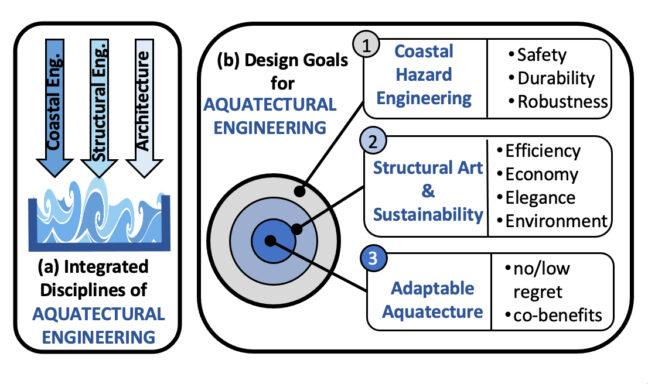BRITE Pivot: Advancing Knowledge in Water – Shell Structure Interaction Through Discovery of Efficient Hydrodynamic and Structural Thin-shell Forms
Funded by the National Science Foundation (NSF), this Boosting Research Ideas for Transformative and Equitable Advances in Engineering (BRITE) Pivot project will lead to scientific discoveries in water-structure interaction, that will enable innovative approaches to coastal resilience. The path to these discoveries establishes and grows a new field, “aquatectural engineering”, which is represented by an integration of three disciplines: structural engineering, coastal engineering, and architecture. The design goals of aquatectural engineering are those of coastal hazard engineering (safety, durability, and robustness), structural art (efficiency, economy, and elegance), and sustainability (low environmental impact). At its best, aquatectural engineering equals adaptable aquatecture, which is characterized by no/low regret strategies (relatively low cost and large benefits under predicted future climates) and has co-benefits (serves more than one purpose). The research outcomes benefit society by enabling robust designs of coastal structures while using less mass (thus more sustainable) via thin-shell forms, and designs that are potentially more elegant and less intrusive to the community and ecosystem. In the field of structural engineering, a plethora of studies have demonstrated the significant strength of thin-shell structural forms, where “shell” refers to the inherent geometric curvature, and “thin” refers to the large span-to-thickness ratio.
The research objective is to enable aquatectural engineering and adaptable aquatecture design goals through the advancement of fundamental knowledge in water – shell structure interaction using integrative approaches: hydrodynamic analyses, finite element structural analyses, and machine learning tools. Specifically, the research will discover efficient hydrodynamic thin-shell structural forms that have broad application to coastal resilience such as seawalls, floodbarriers, floating breakwaters, coastal bridges, and coastal building facades for example. Since thin-shell structures could be susceptible to dangerous impulse (impact) forces of breaking waves, the numerical approach includes Lagrangian-based multiphase (water and air) smoothed particle hydrodynamic (SPH) models. These complex models will be validated with experimental programs at small scale and large scale. Machine learning methods will be used to (1) arrive at efficient structural thin-shell forms given wave characteristics and (2) develop predictive equations for the wave pressure on these forms. Overall, the project will advance knowledge in the relationship between patterned thin-shell structural shapes/forms and (non)breaking wave forces. In addition, this research establishes a new interdisciplinary field, and demonstrates an integrative approach to find optimized coastal structure forms and predictive wave pressure equations.

